Museums and Exhibitions in New York City and Vicinity
| Home | | Museum Guide | | International | | Architecture & Design | | Theater |
GLENN LONEY'S MUSEUM NOTES
CONTENTS, June 2004
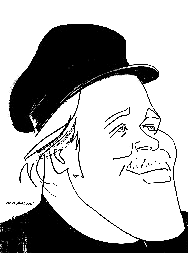
Caricature of Glenn Loney by Sam Norkin.
[01] FROGS: A CHORUS OF COLORS
[02] FACE-LIFT AT THE BROOKLYN MUSEUM
[03] OPEN-HOUSE: Working in Brooklyn
[04] ALEXIS ROCKMAN: Manifest Destiny
[05] PATRICK KELLY: A Retrospective
[06] MODIGLIANI: Beyond the Myth
[07] GOVERNORS ISLAND
[08] Photographs by Lisa Kereszi & Andrew Moore
[09] BLUE LINKS for the Waterfront
[10] KÖRPERWELTEN: Fascination Beneath the Surface
[11] DANGEROUS LIAISONS
[12] Fashion & Furniture in the 18th Century
[13] PAINTERS OF REALITY
[14] The Legacy of Leonardo & Caravaggio in Lombardy
[15] The Pierre & Maria-Gaetana Matisse Collection
[16] CHRISTO & JEANNE-CLAUDE: The Gates, Central
Park, New York
[17] AUGUST SANDER: People of the Twentieth Century
[18] A Photographic Portrait of Germany
[19] ANDY GOLDSWORTHY On The Roof
Copyright © 2004 Glenn Loney. For editorial and commercial uses of the Glenn Loney INFOTOGRAPHY/ArtsArchive of international photo-images, contact THE EVERETT COLLECTION, 104 West 27th Street, NYC 10010. Phone: 212-255-8610/FAX: 212-255-8612.
At the American Museum of Natural History:
 |
| GET
YOUR WAXY FOOT OFF MY HEAD!--Waxy Monkey Frogs at the American Museum
of Natural History. Photo: Courtesy of AMNH. |
[Closing October 3, 2004]
None of the colorful live frogs currently on display at the American Museum of Natural History will turn into a handsome young prince, no matter how much you kiss them. In fact, as they are all behind glass in simulated natural habitats, you cannot get that close to them.
Nor would you want to even touch any of the vividly colored Poison Dart Frogs! Don't even think about it!
On view are some 200 living, breathing frogs from 17 nations around the world—including Vietnam. They represent 24 species, from the tiny Golden Mantella Frog to the huge African Bullfrog.
Following on the American Museum's live butterfly show, its new Live Frog Panorama is almost as colorful. In addition to the actual frogs in their habitats, there are large rear-lit frog-photos, showing details not easily visible in the cases. There are also recordings of Frog Music—the chirps, croaks, and trills of many kinds of frogs.
Most impressive is the Poison Dart Frog Vivarium, built around a tropical buttress-root tree, and inhabited by over 75 of these deadly frogs. Nine different species of them, in deadly Living Color!
The showcase venue is just off the 79th Street South Entrance Hall. It is a very small space, however, and the intricately designed exhibition makes maximum use of the space in a veritable maze.
So for best views, come early and avoid school-groups!
And, yes, you'll find Kermit in the museum's froggy gift-shop!
FACE-LIFT AT THE BROOKLYN MUSEUM:
 |
| Brooklyn Museum Front Entrance Pavilion and Public Plaza Photo: courtesy of Polshek Partnership Architects. |
Polshek Partners Post-Modernize McKim, Mead & White!
Original Master-Plans for the Metropolitan Museum of Art, the American Museum of Natural History, and the Brooklyn Museum all envisioned immense Beaux-Arts complexes being built in stages to fill a huge block-big architectural footprint.
None of these three great institutions has developed as planned. None—except for the Met—yet fills its entire footprint. Funding problems over decades have been partly to blame. Changing visions of museum uses & functions have also had their impacts on changing planning priorities.
But tastes in architecture and design have changed over the years, as well. So both the Met and the American Museum now are complexes with a jumble of styles.
Fortunately, the various wings house very diverse exhibitions and research facilities, so the architectural envelope for the Temple of Dendur looks nothing like the American Wing—which it adjoins.
And the Rose Space Center at the American Museum is light-years distant from the Beaux-Arts facade which creates, in effect, an immense Memorial to President Theodore Roosevelt.
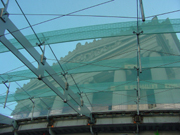 |
| Brooklyn Museum Photo: Courtesy of Polshek Partnership Architects. |
The Polshek Partnership's semi-circular glass & steel apron-approach to the Brooklyn Museum is a curious compromise, however. At eye-level, it virtually obliterates the Beaux-Arts majesty of the original McKim, Mead & White design. Nor do the two conflicting architectural styles make a good match.
Hilton Kramer, art-critic for The Observer, has excoriated both the Post-Modernist addition to the facade and the Museum's director, Arnold Lehman. And not for the first time, either!
New York magazine's architecture-critic, Joseph Giovannini, on the other hand, regards the new Brooklyn Museum entrance as a "warm architectural handshake" to the museum's putative Public.
And, truth to tell, it is very inviting, with a programmed fountain, green-zones, tree-plantings, semi-circular benches, and even the possibility of outdoor entertainments, with the upper level of the new entrance as a stage. The traffic-din of Eastern Parkway, just beyond the seating, may prove a problem unless the performance is ear-splitting Rock.
Actually, the pristine original McKim, Mead & White facade had already been ruined years ago, when the great cascade of second-story-entrance steps was removed, leaving the entrance looking sadly butchered.
The Met still retains its immense stairs on Fifth Avenue, but Brooklynites apparently didn't want to have to climb so high to see the famous paintings and the Egyptian Mummies.
When Brooklyn was NOT an Outer Borough of New York City, but was, instead, the FOURTH LARGEST CITY IN THE UNITED STATES, it made some sense for the millionaires of Brooklyn Heights and Park Slope to plan a museum on the same grand scale as Manhattan's Metropolitan Museum.
Unfortunately, neither the Museum nor the Brooklyn Academy of Music was ever able to draw the masses which flocked to both the Met Museum and the Met Opera across the East River. Over time, the Literati of the Heights preferred to go to Manhattan for their Culture, rather than support local institutions.
In a continuing effort to attract Brooklynites to the Museum, the new entrance and reconfigurations of major galleries have all been designed to make the venue and its splendid collections more appealing to the locals. This is not an Easy Sell, as many in Brooklyn represent Latino and African-American minorities. And Eastern Parkway, opposite the Museum, is home to Super-Observant Orthodox Jews.
In his critical attack, Hilton Kramer condemned the Museum's attempt to become "Community-Oriented." But what else is the Museum to do?
Two of the three current special exhibitions are, in fact, specifically Brooklyn-oriented:
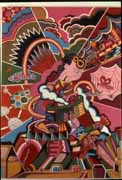 |
| Jovi
Schnell's Pounce in Babel. Photo: Courtesy of the Brooklyn Museum. |
OPEN-HOUSE: Working in Brooklyn
[Closing August 15, 2004]
Struggling artists really cannot afford studio-space on the island of Manhattan anymore. So they have fanned out to Astoria, Queens, and even as far as Hoboken. But Brooklyn has been especially attractive to emerging talents.
To celebrate this quasi-Renaissance in what is legally Kings County, the Brooklyn Museum has opened its doors to a host of Brooklyn-based artists. In fact, there are some 300 works in various media by 200 local artists.
This is transparently an attempt to play to the "Community," to make the Newly-Entranced & Post-Modernly Plaza-ed Museum a magnet for traditional Brooklynites—who have long preferred to find their culture-fixes in Manhattan. And also for members of various Brooklyn minority-groups who do not often go to museums anywhere, unless on school-tours.
Some of these works are arresting, original, and even ingenious. But a number of them seem inspired by the fame & example of more noted artists. The Politics of Race and Gender impact, even infect, some of the artworks.
 |
| Alexis Rockman (American, born 1962) Manifest Destiny (in progress) Photo: Courtesy of the Brooklyn Museum. |
ALEXIS ROCKMAN: Manifest Destiny
[Closing September 12, 2004]
SciFi illustrator Alexis Rockman beat Hollywood to the punch! He unveiled his monster-mural, Manifest Destiny, at the Brooklyn Museum weeks before the world premiere of the end-of-time horror-movie, The Day After Tomorrow.
In the film—a follow-up of the impending Nuclear Horrors of Independence Day—Global Warming leads to a horrendous tidal wave which destroys and submerges New York City.
Less ambitious—but driven by the same Environmental Impulses—Rockman's mural has only 24 feet of length and 8 feet of height to depict a smaller detail of this aqueous destruction. So he has limited himself to showing only part of the borough of a ruined Brooklyn underwater.
The work was commissioned by the Brooklyn Museum, so Rockman thoughtfully restricted his apocalyptic vision of Aquarium Brooklyn. He shows it only from the Brooklyn Bridge up to the Museum itself.
This is a failure of artistic nerve or insight: why not extend the Tidal Flood as far out as Flatbush and drown Brooklyn College as well?
This vast canvas is on display in a long dark corridor on the floor above the newly refigured Main Lobby. At each end, visitors can look down into the lobby from what look like stage-boxes.
Actually, as the art-tunnel has no windows, a number of artworks could be displayed on the facing corridor-walls. But no!
As at MoMA and other gallery/museums with newly elongated exhibition-walls, the tendency is NOT to show more of the usually hidden Permanent Collections, but to encourage Frank Stella and others to paint endless canvases to fill the spaces.
 |
| Shown here with models
in a Paris Collection. Photo: ©Oliviero Toscani/2004u. |
PATRICK KELLY: A Retrospective
[Closing September 5, 2004]
Like the elegant & sexy Negro dancer Josephine Baker long before him, the late African-American artist/designer Patrick Kelly took Paris by storm. He even evoked Baker's banana-fringed Folies Bergères costume, as well as a number of delightful Jazz-Age frock-designs in his very colorful and imaginative costumes.
Born in Mississippi and trained in New York at Parsons, Kelly became the rage of Paris from 1985 until his death from AIDS in 1990. But his visions, ideas, and fashions live on. Glamorous models wearing dazzling Kelly confections strolled among guests at the opening of the Brooklyn Museum's new plaza and entrance. Thelma Golden of Harlem's Studio Museum curated the clothes & visuals on display.
At the Jewish Museum:
 |
| Portrait of Leopold
Zborowski. Photo: Courtesy of the Jewish Museum. |
[Closing September 19, 2004]
This impressive Amadeo Modigliani installation is the centerpiece of the Jewish Museum's Centennial Celebrations. The curious show-title indicates the aim of focusing on Modigliani's actual achievements, rather than on his lifestyle & legend as a quintessential Bohemian. The exhibition does place him in his social context, but it also shows him as a uniquely talented Italian-Jewish Artist in Paris.
But it's interesting to note that Modigliani was only one of a number of foreign-born Jewish artists working in Paris in the late 19th and early 20th centuries. What made him different from them—and certainly contributed to his legend—was his refusal to join any of the new Movements, or to seek fame & fortune as did some of his compatriots.
Also, his portraits and sculptures with the famously elongated features—and his reclining nudes—made him unique among artists of his time, in Paris and beyond. His evocations of images and styles from the Egyptian and Classic are highlighted in this show, which includes some 100 Modigliani works on loan from worldwide collections.
The museum's second-floor galleries are crammed not only with Modigliani works, but also with hordes of the art-loving public who are often lined up outside the old Warburg Mansion on Fifth Avenue. So come early if you want to avoid the crowds and get near enough to the paintings to examine them closely.
At the Urban Center:
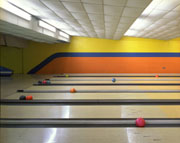 |
| Bowling Lanes. Photo by Andrew Moore |
Photographs by Lisa Kereszi & Andrew Moore
[Closing July 8, 2004]
It's amazing how random snapshots can now command gallery-space. But there is obviously a Larger Purpose involved in showing Lisa Kereszi & Andrew Moore's photos of sites & scenes on Governors Island.
Formerly a US Military Post, the historic island was "returned to the People of New York" in 2003. Its northern half is a National Historic Landmark District.
Former Mayor Rudy Giuliani was pushing for a Major Casino on the site. Others thought it might make another City University campus.
 |
| Steps. Photo by Lisa Kereszi |
This photo-show will help fuel the debate on what is to become of the island itself and of its historic buildings. One photo shows the bottom four steps of a flight of stairs in the Movie Theatre in Building 330. Another snapshot ranges across bowling-lanes. There's also a dark shot of the courtyard of Castle Williams.
The show's on view at the Urban Center of the Municipal Art Society, funded by Target chainstores. It has been organized by Public Art Fund with the Muni Art Society, in collaboration with the Governors Island Preservation and Education Corporation. A lot of brand-names!
There will soon be a 64-page exhibition catalogue, presented by the Public Art Fund.
For more information on the exhibition and/or the Island, contact the Governors Island Preservation and Education Corporation. Phone Yvette DeBow, Director of Marketing, GIPEC: 1212-480-4850. Or try: ydebow@empire.state.ny.us
Also At the Urban Center:
This is not an exhibition. Instead, it is a large-format spiral-bound richly-illustrated presentation of future possibilities for the various waterfronts of Manhattan and the boroughs and even the New Jersey banks of the Hudson River.
Only recently has there been a concerted drive—with exhibitions and tours to match—to heighten public awareness of the leisure-time and tourist potentials of water-edge properties in the area.
American cities such as Houston and Saint Paul have already developed bayous and riverbanks into attractive parks and multi-use public facilities. New York is now making similar plans and putting them into action.
BLUE LINKS is published by the Metropolitan Water Alliance. Free copies are available at the Urban Center of the Municipal Art Society, of which BLUE LINKS is a formal project.
If you would like a copy or want to know more about this fascinating project, contact the Muni Art Society at 457 Madison Avenue, NY, NY 10022. Or try: 1-800-364-9943. Or: www.waterwire.net
OVERSEAS BONUS: On View Somewhere in Germany:
KÖRPERWELTEN: Fascination Beneath the Surface
[Frankfurt & Beyond/Check Local Papers]
[A current CD and press-kit on KÖRPERWELTEN have just been sent me from the Berlin bureau of the New York Times. This is surely because—on a tip from my Times' bureau friend & colleague Victor Homola—I saw this show in Berlin in the summer of 2001. Well before 9/11. So here is a reprise of that review, to accompany images from the new CD!]
ANATOMY ART—A.K.A. PLASTINATION
Your Body Will Never Decay—
It Can Always Be On Display!
Meditation on Mummies—
Had the Pharaohs of Ancient Egypt not insisted on preserving their physical bodies for spiritual use in the Afterlife, our knowledge of that long-vanished culture would be much less. Incomplete certainly.
But, with the current Politically Correct practice of insisting that American Natural History Museums surrender their very ancient skulls & bones so that Native Americans can give them ritual burial in some tribal ground or other, anthropologists are in danger of losing another valuable research resource. Another Key to the Past.
Worst Scenario Yet: If Muslim Fundamentalists decide to take their cue from American Indians, the Metropolitan and the Brooklyn Museums may soon have to give back all their Mummies! Or suffer the consequences…
If you have been able to look at the stunning, shining, mysterious golden mummy-mask of King Tut, you—and countless thousands over time—may well have been dazzled both by the artistic conception and the craftsmanship of that funerary ritual ornament.
And it's almost certain, if and when you saw that celebrated mask, that you then wanted to know much more about this pharaoh who died so young—poisoned by pagan priests? And about his culture, world, and people…
Fortunately, we have Egyptologists, archeologists, anthropologists, and mythologists to thank for the interpretations they have been able to make of the fragments and shards—and the mummies & architecture—of that long-dead culture.
Catholic clerical officials have occasionally dug up a long-dead saint to see if the body has been preserved from decay, a sure sign of Sainthood. Even if only bones remain, they can be wound with strings of pearls—and the gold-crowned skulls studded with jewels.
Baroque Bavaria is especially rich in such venerable religious relics. Also, of course, Italy. Visiting Jesuit Churches, it's a bit unsettling to see a jeweled skull of a Christian Martyr grinning out at you.
Unfortunately, not much can be learned of the saints' lives and times from bones alone.
Ordinarily, however, researchers are not interested in digging up bodies interred only a century or so ago. Unless there is some forensic question about the manner of their deaths: Was Napoleon poisoned?
There is also not much to be learned from opening coffins to see how Proper Victorians were dressed for their potential presentations to either Their Lord—or to the Satanic Deity.
We already have sufficient early 19th century woodcuts and engravings of Famous Corpses Lying in State. Newspaper accounts of that time itemize their burial finery, not to overlook the hymns sung, the sermons preached, and the lists of mourners and pall-bearers.
So we really don't need to exhume them.
Unless you do not believe that General Ulysses S. Grant is actually buried in Grant's Tomb. Alongside his loving wife, Julia Dent Grant…
However, saintly people from the last century have been disinterred, but not for scientific purposes. If they merit sainthood, their remains can then be prepared for reverent repose or venerated exposure in shrines.
But without the ropes of baroque pearls wound round their extremities. Tastes and fashions—even in adorning the sanctified dead—change over time. Still, these almost Pharaonic—but actually Roman Catholic—religious practices do owe something to ancient beliefs & traditions…
If you have ever read Jessica Mitford's The American Way of Death, you were probably shocked to learn that many modern corpses are prepared for Open-Coffin funerals with clothes that have no backs to them. Mourners are not about to turn the corpse over. It is usually enough to say: "She doesn't look the least bit life-like!"
Well, why should she? She is dead, after all…
Imagine Jackie Kennedy Onassis' embarrassment, on Meeting Her Maker, if she were to discover that her lovely gown had no rear panel to it!
Orthodox Jews are not embalmed and must be buried the day after death. So there would be little of interest remaining of an ordinary man for either anthropologists or forensic experts a century or so after death. The remains of Theodore Herzl might be a different matter…
If you have ever wondered, however, what might happen to your own embalmed and buried body were it to be exhumed a thousand years from now, don't worry about it. You won't be around to see it. If they haven't already nuked the cemetery…
And so much about our life & times has already been written, spoken, and recorded, that digging up some run-of-the-mill corpses won't tell them much.
In any case, for what they need to know, they can open the New York Times' Time Capsule. Designed by Santiago Calatrava, it is now sitting proudly in the parkland of the American Museum of Natural History, waiting to be opened in 3001!
But by that distant time, Manhattan might well be under 300 feet of sea-water… Divers could retrieve the Time Capsule from the "Manhattan Shelf."
If you give the matter some thought, you might be tempted to regard King Tut's Tomb as an Ancient Egyptian Time Capsule. But then, they left so many of them strewn about the Nile Valley.
Prof. Dr. Gunther von Hagens Will Preserve Your Body!
There is now an amazing way to preserve your earthly body for the forseeable future—and then some. This method is called PLASTINATION. It has been developed by Dr. Gunther von Hagens, notably when he was a professor at Heidelberg University.
Remaining in historic Heidelberg, he now has his own scientific institution for further research in human tissue-preservation and preparing specimens for educational purposes. And even for artistic/aesthetic exhibitions.
It has always been very difficult for medical researchers to obtain bodies for dissection. Religious beliefs and civil laws have largely forbidden this practice over the centuries.
So scientists such as Leonardo da Vinci and later medical researchers had to find their cadavers where—and as—they could. Grave-Robbers were not only looking for rings, jewelry, and watches on the corpses they dug up at midnight. The corpse itself might fetch a good price at the medical school…
Even today, there are not enough cadavers for all the new medical students to dissect and learn about the complexities of the human body. Shortly after death—even with cooling and partial embalming—the organs begin to deteriorate.
So Dr. Von Hagens began experimenting with ways to preserve donated bodies for such teaching and research.
In perfecting Plastination, he has also been able to preserve permanently fully dissected bodies—with muscles and organs standing out from the skeletal structure, to show how all the elements inter-relate.
And he has also been able to slice preserved bodies into cross-sections, vertically or horizontally, to demonstrate in depth the shape. position, function, and appearance of various organs.
As each body differs in some respects from others, both students and doctors find it valuable to see how such differences may effect surgical operations and treatments.
While accident-victims and the dying can now leave body-parts for use in other living bodies, Plastination permits the use of the entire body after death for scientific and humanitarian endeavors.
Dr. Von Hagens has prepared a number of very impressive mountings of human-bodies, body-parts, and body-systems for demonstration purposes. Not least to encourage people to consider donating their bodies for this new form of Physical Immortality.
He and his co-workers have, however, been so ingenious in preparing their specimens that they began to view them as a new form of artwork. So, from showing them in medical lecture-halls and research labs, it was only a small step to organizing a public exhibition.
This is called ANATOMY ART, and it was on view this past summer in Berlin. It filled the vast spaces of the Alte Post Bahnhof, accommodating thousands of entranced visitors. It has already been shown in Japan and in other leading German cities.
Apparently, there are no current plans to bring it to the United States. It may seem just too ghoulish for many American museums and galleries to program. Even on the videotape for the show, the English voice-over suggests that once you have "overcome your initial revulsion," the figures can seem quite beautiful.
Yes, there is a video, poster, catalogue, and T-shirts! These currently fashionable Museum Show Accessories suggest an exhibition orientation more commercial than scientific.
Nonetheless, Dr. Von Hagens' institute needs both ongoing funding and more bodies. It was clear to me—who did in fact have some difficulty in "overcoming my initial revulsion"—that most of the hordes of exhibition visitors were fascinated with what they saw there. And some indicated they'd like to have their bodies preserved.
Any three-pack-a-day smoker should quit cold after looking at the plastinated lungs of a long-time smoker, compared with healthy lungs. Smokers' lungs are gray or black!
Once plastinated, they will stay that way for years—long after their previous owner has died of lung-cancer. Yes, you can also study the development of tumors and embolisms in Dr. Von Hagens' specimens.
You can even see the body of a young pregnant woman, her stomach cut open to reveal the almost fully-grown fetus in her abdomen. Almost too much for me, though I had a difficult time photographing some displays owing to the constant crowds on all sides of the figures.
A man stands tall, holding his own plastinated skin over one hand, like a jump-suit! Two muscular men—their muscle-systems clearly exposed—fight a duel with fencing-foils.
A male figure seems to open a drawer in his mid-section, inviting inspection of his stomach. But all over his preserved body, square and rectangular sections are pulled out, with various organs exposed.
The idea of strangers going through your bureau-drawers after you are dead is unsettling enough. But the idea of people looking at your own body like a chest of drawers—open for inspection—was too much for me.
One colorful specimen is the entire blood-red circulatory system in clear plastic.
The big showpiece of Anatomy Art, however, is a dissected horse & rider, leaping up in the air. It could be a heart-stopping horror in a Tim Burton film.
Because Gunther von Hagens is always photographed wearing a wide-brimmed black fedora—rather like the late avant-garde artist Joseph Beuys, from whom he may well have borrowed "The Look"—it is clear that he does think of himself as an Artist as well as a Scientist.
In a handsome booklet—INFORMATION BROCHURE ON DONATING YOUR BODY FOR PLASTINATION—Dr. Von Hagens explains the preservation-process. Body fats and water are replaced with "reaction plastics," such as silicon, rubber, or epoxy resin.
Even the tiniest cell-structure is accurately preserved. The effect is quite remarkable. But let the good doctor describe it himself:
"By placing the specimen in a tank of cold solvent (e. g. in acetone), first the water in the tissue and then the fat in the tissue is gradually replaced by the solvent at room-temperature. The specimen, from which the fat and the water have now been removed, is then placed in the plastic solution. The solvent is then brought to the boil in a vacuum and continuously sucked away. This causes a volume deficit in the specimen which allows the plastic gradually to permeate every cell. This 'forced impregnation' is a very slow process which takes days and weeks, thus ensuring that all the tissue structures are retained. The plastic is then hardened, using gas, light, or heat, depending on which plastic was used in the first place."
The Renaissance researcher, Andreas Vesalius, performed public dissections for interested spectators. Dr. Von Hagens has included in his exhibition a reproduction of a very old engraving showing Vesalius at work in medical-school amphitheatre.
Gunther Von Hagens regards this as the precursor of what he calls "Anatomical Theatre." So it was only a small stretch of the imagination for him to call his own plastinated figures "Anatomy Art."
In the centuries after Vesalius and Da Vinci, both medical schools and museums maintained rooms with preserved animals, fetuses, malformed babies, two-headed calves, diseased organs, human brains, and other pickled body-parts.
When Austrian composer Franz Josef Haydn died, his head was severed from his body. So that the brain of this musical genius could be more closely studied and admired.
Only in the latter part of the 20th century was the head reunited with the corpse. The Russians had taken it from Vienna after World War II, while the body was preserved in state in a great sarcophagus in Eisenstadt. This is the site of the magnificent Eszterhazy Palace—where Kapellmeister Haydn wore the Prince's livery like any other servant of the Greatest Magnate in Austro-Hungary.
In 19th century America, the great showman, P. T. Barnum showed preserved freaks in his American Museum. So there is a long tradition of this kind of exposure of dead bodies.
Dr. Von Hagens plans to create a special museum for his artfully arranged figures. You could become one of them!
The Body Donation Office in Heidelberg can be phoned: 011-49-6221-3311-50.
Dr. Von Hagens is planning annual informational meetings for potential donors. He proposes to show specimens, provide more detailed information about plastination developments, and encourage an exchange of views.
This would surely be in Heidelberg, where his HQ is right in the middle of this romantic old Renaissance city—with its great ruined castle. In fact, he's to be found at Rathaus-Strasse 81!
[From 1956-59, Heidelberg was also my HQ, when I taught for the University
of
Maryland Overseas, servicing the American Occupation Forces. We held our graduations
in Heidelberg University's Neue Aula, or New Hall. Actually,
the correct name of this august institution is Ruprecht Carolus University—and
the tuition is minimal, compared even with American Land-Grant public universities.
But you have to be able to function in German…]
If you would like to know where and when Von Hagens' amazing exhibition can be seen—or simply to learn more about the process and its uses—phone: 011-49-6221-3311-0. One digit less than the number for donating your human remains.
With any luck, your Immortal Soul will have drifted on to a Better Place…
At the Metropolitan Museum:
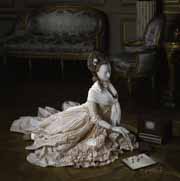 |
| THE
SITTER'S FRIEND--Dress (Robe à l'anglaise) Ivory and pink striped
silk taffeta, French, 1785-87 Purchase, Irene Lewisohn Bequest, 1966 (C.I.66.39a,
b) |
Fashion & Furniture in the 18th Century
[Closing August 8, 2004]
At the Met Museum, the annual Big Event is the Costume Institute Party of the Year. It is usually centered around a show in the cramped below-stairs costume-galleries. Not since the Glory Days of the late Diana Vreeland has there been a proper venue for costume-display and mighty Museum's mammoth fund- & self-esteem-raisers.
Now, for the first time in memory, historic costumes are shown in proper period architectural and social contexts. Eighteenth Century aristocrats now populate the lavish Wrightsman Galleries period-rooms.
Emphasis is placed on the uses of architecture, decoration, and costume to create an atmosphere not only of luxury, but also one conducive to seduction. The various scenes set up in the handsome rooms are certainly provocative.
But they also give a good idea of how these idle gentlemen and ladies actually lived. Imagine having to ascend a step-ladder to dress a lady's ornate & elaborate wig!
The historical—and metaphorically-appropriate—Cut-Off Point for the exhibition is 1789. The Year of the French Revolution and the Guillotine, which cut off many of the seducers' heads. As well as some royal & noble Seductees…
With models artfully posed in some 30 period costumes, this exhibition explores "the body's spatial negotiation of the 18th century interior as a choreography of seduction and erotic play."
If only the Revolting Masses had known what was really going on in all those French Chateaux and Paris Hôtels, the Bastille would have fallen much sooner!
 |
| Andrea Solario
(Milan, ca. 1465-Milan 1524) Salome with the Head of John the Baptist,
ca. 1506-7 Oil on canvas, 57.2 x 47 cm; The Metropolitan Museum of Art,
New York. The Friedsam Collection, Bequest of Michael Friedsam, 1931 |
The Legacy of Leonardo & Caravaggio in Lombardy
[Closing August 15, 2004]
Cremona is justly famous for violins by Antonio Stradivari. But it also has important collections of Renaissance & Mannerist Art. The new blockbuster show at the Met is not interested in Mannerism, however. Instead, it focuses on the "New Naturalism" and images of Reality from the 15th to the 18th centuries, especially as practiced in Lombardy.
Leonardo da Vinci was working in Milan in the Renaissance, and his sketches and notes on the Natural World are now considered masterpieces. He and Caravaggio are the titular totems of this impressive show, but other Italian painters in Lombardy are also featured. They are certainly lesser-known but hardly deficient in talent.
Although Caravaggio is often associated with the development of the Baroque sensibility, his attention to natural detail first won him acclaim. Painting the corpse of a dead woman for a vision of the Dormition of the Blessed Virgin is about at "natural" as a painter could get. This was, in fact, too natural for some viewers & critics.
Among others on view are Annibale Carracci, Lorenzo Lotto, Moretto da Brescia, Giacomo Ceruti, Andrea Solario, Giovanni Girolamo Savoldo, and the women-painters Sofonisba Anguissola and Fede Galizia.
There is also one of those vegetable/fruit portraits by Giuseppe Arcimboldi: The Vegetable Gardener.
Although the historic City of Mantua is alluded to in this exhibition—with a photo of the Palazzo Te in a catalogue—its great genius, Giulio Romano, doesn't seem to qualify as a Realist. But then his great mural of Samson pulling down the pagan pillars of the Temple of Baal is more fantasy than actuality.
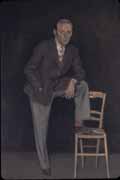 |
| MATISSE'S MATISSE
BY BALTHUS! Photo: Courtesy of Metropolitan Museum. |
The Pierre & Maria-Gaetana Matisse Collection
[Closing June 26, 2004]
In one sense, it could not have been easy to be the younger son of the very famous French Impressionist painter, Henri Mattise. Even had Pierre Matisse been driven to follow his father at the easel, his talents would have always been in the shadows of his père.
Fortunately, he chose to be an art-dealer and gallerist, so his father's canvases—and his father's contacts with other notable French Modernists—helped him found a major gallery in New York City. Here, he was able to introduce new continental talents to American collectors, as well as to provide important works by major names.
In his career of some 60 years, he also assembled an impressive personal collection. Some of these painting, sculptures, and drawings had already been donated to the Met Museum by Matisse and his wife, Maria-Gaetana Matisse.
Following the death of his widow, the Matisse Foundation has also given the Met a further gift of over a hundred works in various media. Artists included in this eclectic collection are Balthus, Chagall, Derain, Dubuffet, Giacometti, Magritte, Miró, Tanguy, and, of course, Henri Matisse.
The current show is only the first of three, designed to explore the entire gift-collection. The second exhibition will open at the Met on September 28, followed by the third on January 30, 2005.
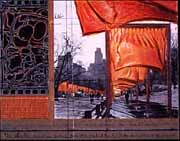 |
| CHRISTO'S CENTRAL
PARK GATES PROJECT. Photo: Courtesy of Metropolitan Museum. |
CHRISTO & JEANNE-CLAUDE: The Gates, Central Park, New York
[Closing July 25, 2004]
Way back in the summer of 1995, when Christo & Jeanne-Claude were Wrapping the Berlin Reichstag, I found I had to be on site no later than 6:30 am if I hoped to snap a shot of them inspecting the progress of this epic undertaking.
It was an amazing accomplishment: some Berliners said the old Wilhelmian Parliament had never looked so good as now: Under Wraps. Fortunately, I was able to make many slides and prints of the stages of this astonishingly engineered project.
Later, in the Autumn, in the Great Hall of Cooper Union, they made a presentation of their work, especially show-casing The Gates for Central Park. This beautifully imagined enhancement of the park's miles of walkways had been repeatedly rejected by various City Authorities and Civic Groups.
After the presentation, Christo & Jeanne-Claude talked with me on tape for WBAI about this wonderful concourse of wind-driven rippling golden fabric panels floating above the park's many paths, secured at the sides with strong metal U-shaped rods.
Obviously, no damage, permanent or temporary, would be done to Central Park's historic structures, gardens, or overall plan. Yet that was the principal complaint of would-be Park-Protectors. Some of the Fifth Avenue Millionaires despaired of having their fabulous Park-Views spoiled by Christo's golden banners.
And some fierce Anti-Christo Fighters were—and some still are—furious at what they regarded as purely Another Christo Self-Promotion.
Christo's Running Fence, Surrounded Islands, Wrapped Reichstag, and Umbrellas—in both Japan & California—had repeatedly demonstrated his ability to enhance momentarily both Natural Environments and Man-made Constructions to everyone's advantage and enjoyment. With no subsequent harm to the land or buildings.
What many of Christo & Jeanne-Claude's opponents do not realize—or do not want to hear—is that all the projects are financed by the monies the duo raise from sales of his impressive artworks of his plans for the various projects. Not from your Taxes!
A number of these Central Park GATES artworks are now on display at the Met in the American Wing. Also on view are engineering drawings. As well as photos of the fabrication of the fabric-panels and metal supports, plus actual examples of the materials which will be used in Central Park. This is not to be missed, especially for school-groups!
AUGUST SANDER: People of the Twentieth Century
 |
|
Farm Children,
c. 1913. Photo by August Sander (German, 1876-1964). © 2004 Die
Photographische Sammlung/SK Stiftung Kultur-August Sander Archiv, Cologne/ARS,
NY |
A Photographic Portrait of Germany
[Closing September 19, 2004]
It's a very good thing that color-photography was virtually unknown when August Sander began making his stark black & white photo-portraits of Germans from "All Walks of Life." Color might have given his subjects a warmth and humanity they do not have in his almost clinical & affectless images of Teutonic Rigidity.
Although Sander began capturing images of German farmers, university Studenten-Korps duellers, shop-keepers, family-groups, roving peddlers, politicians, clowns, jugglers, philosophers, poets, actors, industrialists, dancers, authors, aristocrats, authority-figures, and military-units long before the Nazis came to power, his own classification-system of German social types or occupations actually complemented some of the Nazis' own categories.
There are some 150 of Sander's powerful images on view at the Met. This show is complemented by the pendant: Indexing the World, with images of people and places by the earliest and most recent Big Name photographers: From Fox Talbot to Thomas Struth.
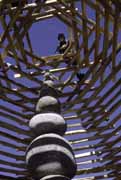 |
| Andy Goldsworthy
with Stone Houses (2004) during installation The Metropolitan Museum of Art, The Iris and B. Gerald Cantor Roof Garden (Andy Goldsworthy, Stone Houses, 2004, wood and stone, Courtesy of the artist and Galerie Lelong. © Andy Goldsworthy; courtesy Galerie Lelong) Photography by Teresa Christiansen Photograph Studio. Photo: Courtesy of Metropolitan Museum. |
[Closing October 31, 2004]
No Question but Andy Goldsworthy is one of the most interesting artists now working in and with Natural Environments. Photos of some of his fascinating site-specific sculptures and installations in natural settings may make you want to book a flight to see them, no matter how remotely they may be sited.
Now his work has not only come to the Cantor Roof garden at the Met, but it has been specifically commissioned for this artificial site, which overlooks Central Park, Cleopatra's Needle, and the City, seen East, West, and South.
Goldsworthy intends that his two dome-shaped split-rail structures will "command the space," which they certainly do. But they do not immediately relate to the roof—although they almost fill its space. Nor do they really relate to the park & trees below.
The actual wood-rails of his Stone Houses installation/construction come not from Central Park trees, but from "New England agricultural sources." Whatever that euphemism may conceal… The two columns of rounded stones—one inside each rail-dome—come from Luce Bay in Southern Scotland. Certainly a long way off from Fifth Avenue!
Goldsworthy's problem with this commission may well be that the site is Not Natural. [Loney]
Copyright © Glenn Loney 2004. No re-publication or broadcast use without proper credit of authorship. Suggested credit line: "Glenn Loney, Curator's Choice." Reproduction rights please contact: jslaff@nymuseums.com.